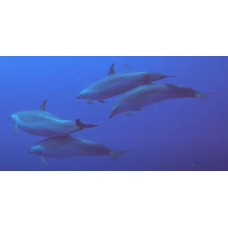Latin name
Stenella attenuata
Other names
Stenella attenuata
Identification
The Pantropical spotted dolphin varies considerably in size and coloration throughout its range. The most significant difference is between the coastal and pelagic species. The coastal form is larger and more spotted. (These two forms have been separated into subspecies only in populations in the eastern Pacific). Spots are the main distinguishing feature of adults; immature individuals tend to be uniformly colored and are easily confused with common bottlenose dolphins. Populations in the Gulf of Mexico may be without distinguishing marks even when mature. In the Atlantic, they can be confused with Atlantic spotted dolphins.
The body of these dolphins is quite slender, streamlined, with a dark cape and hood. They have bright spots on their body that increase in number and size as they mature. This species has a long, slender beak.
Features of fish fins
The Pantropical spotted dolphin has a sickle-shaped dorsal fin, which is the thinnest of all dolphins.
Fish colouring
The upper and lower jaws are dark, but separated by thin white "lips". The chin, throat, and belly are white to pale gray with few patches. The flanks are divided into three distinct color bands - the lightest at the bottom, followed by a thin gray band in the middle of the flank and a dark gray back. The high, concave dorsal fin is similarly colored. The thick tail matches the color of the central band.
Distribution
It is one of the most abundant species in the Atlantic and Indian Oceans. It is the second most abundant cetacean after the common bottlenose dolphin. The range includes some enclosed seas, such as the Red Sea and the Persian Gulf, but does not include the Mediterranean Sea.
Habitat
Widespread in tropical and marine waters from 40°N to 40°S. Centers of greatest population density are in shallow waters with the warmest water bodies (water temperatures above 25°C). They also tend to concentrate where there is a high temperature gradient.
Size
Length at birth is 80-90 cm. Adults reach a length of about 2.5 m and a weight of 110 to 140 kg.
Behavior
Very active and prone to large jumps with splashing water. They often dive into the water and emerge for a second or more.
Food and feeding habits
It feeds on small fish, squid and crustaceans.
Reproduction
Sexual maturity occurs at 10 years for females and 12 years for males. Average life expectancy is approximately 40 years.
Fishing
Despite widespread "dolphin-safe" practices, the negative impacts of fishing activities continue. Rather than reducing numbers through direct mortality, fishing activities have affected the reproductive function of the species.
Relationship with a person
Playing with and escorting boats is common for these dolphins.
| Classification | |
| Phylum | Chordata |
| Class | Mammalia |
| Squad | Artiodactyla |
| Family | Delphinidae |
| Genus | Stenella |
| Species | S. attenuata |
| Features | |
| Conservation status | Least Concern |
| Habitat | Pelagic |
| Life span, years | 40 |
| Maximum body weight, kg | 140 |
| Maximum length, cm | 250 |
| Sailing speed, m/s | No information |
| Threat to people | Edible |
| Way of eating | Predator |



